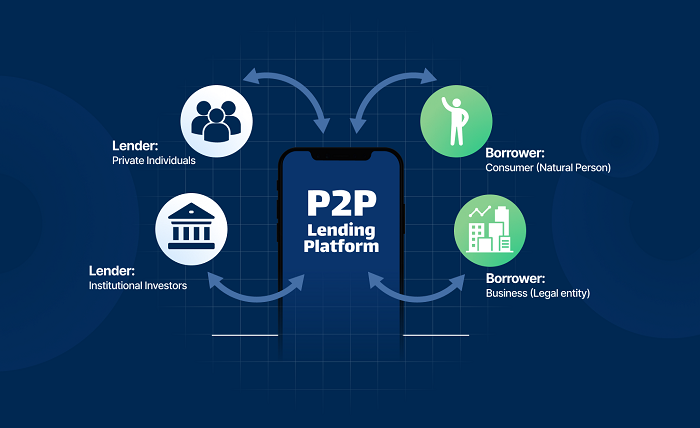
The P2P lending market is projected to reach $1 trillion by 2027. Surprisingly, 43% of platforms right now fail within three years due to inadequate technical architecture.
P2P lending software development requires robust core systems that can scale with growth. In this article, I’ll explain what features these systems can benefit from.
1 – Distributed Risk Assessment Engine
Traditional centralized risk models that work fine for small lending operations turn into serious obstacles as platforms scale. When transaction volumes surge, these monolithic systems either slow to a crawl or crash completely. That results in both technical and financial risks.
Centralized risk engines face multiple challenges:
- Processing bottlenecks during high-volume periods;
- Update limitations that slow model improvements;
- Single points of failure affecting the entire platform;
- Inflexible architectures that resist incorporating new data sources.
LendingClub discovered this the hard way when their growth surged 400% in 18 months. This caused their centralized risk system to become both a technical obstacle and a risk assessment liability.
Effective distributed risk assessment typically employs:
- Microservices-based risk components that independently evaluate different risk factors;
- Event-driven architecture that processes loan applications asynchronously;
- Data pipeline optimization for real-time credit data ingestion;
- Model registry and versioning system for systematic risk model updates.
This architecture allows individual risk components to scale independently based on demand. At the same time, it enables rapid iteration of specific risk models without disrupting the entire system.
Implementation Approach for Adaptive Credit Scoring
Leading platforms implement adaptive scoring using:
- Federated ML models that combine multiple risk signals;
- Champion/challenger testing framework for continuous model improvement;
- Multi-factor weighting systems that adapt to market conditions;
- Regional calibration capabilities for geographic variations.
Key performance metrics to properly measure the distributed risk engine’s effectiveness:
| Metric | Target Range | Warning Threshold |
| Risk Scoring Latency | <200ms | >500ms |
| Model Update Deployment Time | <2 hours | >24 hours |
| Application Processing Capacity | 10× peak hourly volume | <5× peak hourly volume |
| Concurrent Model Versions | Support for 3+ | Only 1 active model |
2 – Real-time Fraud Detection System
P2P lending platforms face sophisticated fraud attacks that constantly evolve. Traditional rule-based detection systems quickly become obsolete against these dynamic threats.
Effective fraud detection combines multiple technical approaches:
Behavioral biometrics that detect unusual interaction patterns
- Keystroke dynamics analysis
- Mouse movement pattern recognition
- Session behavior profiling
Transaction anomaly detection
- Velocity checks across multiple dimensions
- Network relationship analysis
- Pattern deviation scoring
Device fingerprinting and verification
- Hardware configuration identification
- Connection characteristics analysis
- Emulation/automation detection
These systems work in concert, with suspicious signals from any component triggering enhanced scrutiny from others.
Machine Learning Approaches for Evolving Threats
Static fraud models quickly become ineffective. Leading platforms implement:
- Unsupervised anomaly detection to identify previously unknown patterns;
- Supervised classification for known fraud vectors;
- Semi-supervised models that combine labeled and unlabeled data;
- Online learning capabilities that update in near-real-time.
Integration Strategy with Lending Workflow
Fraud detection must balance security with user experience:
- Risk-based authentication that increases verification only when necessary;
- Progressive identity validation throughout the application process;
- Transparent background verification with minimal user friction;
- Configurable risk thresholds that adapt to specific lending products.
3 – Multi-tier Liquidity Management System
Matching borrowers with lenders at scale takes sophisticated liquidity management that can handle millions of microtransactions without capital inefficiencies.
Advanced liquidity management systems typically feature:
Hierarchical pool structures
- Primary liquidity reserves for immediate matching;
- Secondary pools for specialized loan categories;
- Overflow management for capital optimization.
Real-time balance reconciliation
- Continuous accounting synchronization;
- Pending transaction reservation systems;
- Atomic transaction processing.
Implementation Strategy for Automated Fund Allocation
Effective allocation implies balancing multiple objectives:
- Risk diversification algorithms that optimize investor portfolios;
- Loan fulfillment prioritization based on multiple factors;
- Auto-investment rules engines with configurable parameters;
- Capital utilization optimization to minimize idle funds.
Performance Optimization for High-Volume Processing
Transaction volume can quickly overwhelm conventional systems. Key optimizations include:
- In-memory transaction processing for high-throughput operations;
- Database sharding strategies for horizontal scaling;
- Eventual consistency models for non-critical operations;
- Asynchronous processing for batch operations.
Transaction Throughput Benchmarks
Competitive platforms typically maintain:
- Peak transaction processing: 5,000+ transactions per second
- Settlement confirmation: <2 seconds
- Daily transaction capacity: 100× average daily volume
- Batch processing windows: <4 hours for complete system reconciliation
4 – Configurable Regulatory Compliance Framework
Effective compliance frameworks have:
- Rules engine abstraction that separates compliance logic from business logic;
- Jurisdiction-specific rule repositories with versioning and audit trails;
- Configuration-driven compliance processing instead of code changes;
- Regulatory update workflow for systematic rule deployment.
The compliance framework is supposed to function as an independent service. It means the framework has to include the following:
- API-based compliance verification that other services call when needed;
- Centralized decision logging for audit purposes;
- Configurable rule priorities for resolving conflicts;
- Real-time rule updates without system restarts;
Testing Framework for Regulatory Scenarios
Comprehensive testing should encompass:
- Scenario-based testing for specific regulatory requirements;
- Regression testing when rules change;
- Continuous compliance verification in production environments;
- Audit trail validation for regulatory inspections.
5 – Extensible API Ecosystem
The most successful P2P lending platforms function as financial ecosystems. This can only be possible if you have a robust API architecture from day one.
Well-designed APIs enable:
- Third-party service integration (credit bureaus, payment processors, etc.);
- Partner application development that extends platform functionality;
- White-label solutions for institutional clients;
- Mobile and web client flexibility independent of backend changes.
Platforms with comprehensive API strategies typically generate 30-50% more revenue through partnership channels than closed-system competitors.
Technical Architecture for Secure, Scalable API Design
Successful case studies demonstrate:
- API gateway architecture for security and traffic management;
- Versioned endpoints that ensure compatibility;
- OAuth 2.0 and API key authentication with granular permissions;
- Rate limiting and quotas to prevent abuse;
- Comprehensive documentation and SDKs for developer adoption.
Implementation Approach for Partner Integration
Successful API ecosystems take more than just technical endpoints:
- Self-service partner onboarding with automated approval flows;
- Sandbox environments for partner development and testing;
- Usage analytics dashboards for partners and internal teams;
- Developer community support resources and forums.
Conclusion
These five components must work together as an integrated system. Not as isolated features. If you target a successful implementation, think of:
- Unified data architecture that supports all components;
- Consistent security model across all systems;
- Centralized monitoring and alerting for proactive management;
- Scalable infrastructure design that anticipates growth;
- Modular architecture that allows independent component evolution.

